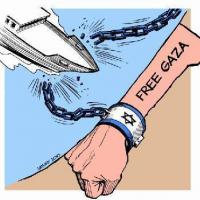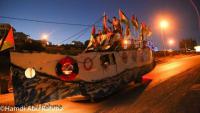Israel hat am Dienstag den tunesischen Expräsidenten Moncef Marzouki und die spanische Europapolitikerin Ana Miranda Paz abgeschoben, die sich an der Gaza-Hilfsflotte beteiligt hatten. Auch 14 weitere ausländische Teilnehmer sollen kurzfristig ausgewiesen werden. Die israelische Marine hatte die »Freiheits-Flottilla III« am Montag kurz vor Erreichen der Gewässer des Gazastreifens gestoppt und das schwedische Schiff »Marianne von Göteborg« nach Israel gebracht; die übrigen Schiffe der Hilfsflotte drehten wieder ab.
Der arabisch-israelische Parlamentsabgeordnete Bassel
Ghattas wurde in Aschdod nach einem Polizeiverhör freigelassen. Ghattas
bezeichnete das Vorgehen der Kriegsmarine gegen das schwedische Schiff
als illegal. Letztlich sei das Hauptziel der Freiheitsflottille erreicht
worden, die lokale und internationale Aufmerksamkeit auf die humanitäre
Krise im Gazastreifen zu lenken, so Ghattas.
http://www.jungewelt.de/2015/07-01/048.php
Israel once again commits an act of state piracy in the Mediterranean
today
(Gaza time) the “Marianne” contacted Freedom Flotilla Coalition (FFC)
and informed us that three boats of the Israeli navy had surrounded her
in international waters, while sailing approximately 100NM from Gaza
coast. After that we lost contact with the “Marianne” and at 05:11AM
(Gaza time) the IDF announced that they had “visited and searched”
Marianne. They had captured the boat and detained all on board “in
international waters” as they admitted themselves. The only positive
content in the IDF announcement was that they still recognize that there
is a naval blockade of Gaza, despite Netanyahu’s government recent
denial that one exists.
We have no reason to believe that
Marianne’s capture was “uneventful”, because the last time the IDF said
something like that, in 2012, the people on board the “Estelle” were
badly tasered and beaten with clubs. Back in 2010, ten passengers of
Mavi Marmara were murdered by the IDF during a similar operation in
international waters.
https://ff3.freedomflotilla.org/israel-once-again-commits-an-act-of-state-piracy-in-the-mediterranean/
IDF violence against 'Marianne' peace sailors
https://www.youtube.com/watch?v=HRgUEzUOfXA&feature=youtu.be
Flotilla passengers say Israeli navy tasered activist during raid
http://www.middleeasteye.net/news/breaking-flotilla-ship-captured-israeli-navy-arrives-ashdod-207929279
Moroccan flotilla to Gaza in next few days
http://www.maannews.com/Content.aspx?id=766249
Letzten Infos
https://twitter.com/hashtag/SOSFreedomFlotilla?src=hash
Bild :
Palestinian
activists held a demonstration Monday night in Ramallah to protest
Israel's interception of Freedom Flotilla III earlier in the day and to
salute the flotilla's brave crew.
http://www.alternativenews.org/english/index.php/activism/popular-resistance/908-see-ramallah-solidarity-with-gaza-flotilla
Mehr Bilder , facebook.com/PopularStruggle/photos/pb.218774474818321.-2207520000.1435699088./1114902321872194/?type=1&theater



http://www.ynetnews.com/articles/0,7340,L-4673887,00.html
"It looks like you took a wrong turn," read the letter. "Perhaps you meant to sail to a place not far from here - Syria. Where Assad's regime is slaughtering its people on a daily basis, and this is done with the support of Iran's murderous regime.
Israel transports goods and humanitarian aid into the Gaza Strip - up to 800 trucks a day. In the past year we enabled the entry of over 1.6 million tons of products, an average of one ton per person in the Gaza Strip. By the way, these supplies are equivalent to 500,000 boats like the one you came in on today.
Israel provides assistance to hundreds of humanitarian projects through international organizations, including the building of clinics and hospitals.
However, we will not allow the terrorist organizations to transfer weapons into the Gaza Strip by sea. Only one year ago, we thwarted an attempt to smuggle hundreds of weapons into the Gaza Strip by ship. These weapons were meant to target innocent Israeli civilians.
There is no siege on the Gaza Strip, and you are welcome to transfer any humanitarian supplies for the Gaza Strip through Israel.
If you were truly concerned about human rights, you would not be sailing in support of a terrorist regime which summarily executes citizens in the Gaza Strip, and uses children as human shields."
“The idea is to put the Palestinians on a diet, but not to make
“The idea is to put the Palestinians on a diet, but not to make them die of hunger.”
Dov Weisglass was adviser to Ehud Olmert
But a rather different picture emerges as one reads the small print. While the health ministry determined that Gazans needed daily an average of 2,279 calories each to avoid malnutrition — requiring 170 trucks a day — military officials then found a host of pretexts to whittle down the trucks to a fraction of the original figure.
The reality was that, in this period, an average of only 67 trucks — much less than half of the minimum requirement — entered Gaza daily. This compared to more than 400 trucks before the blockade began.
To achieve this large reduction, officials deducted trucks based both on an over-generous assessment of how much food could be grown locally and on differences in the “culture and experience” of food consumption in Gaza, a rationale never explained.
https://electronicintifada.net/content/israels-starvation-diet-gaza/11810
“Every third child in Gaza stunted by hunger”: interview with renowned doctor Mads Gilbert
https://electronicintifada.net/content/every-third-child-gaza-stunted-hu...
Das Hilfswerk der Vereinten Nationen für Palästina-Flüchtlinge im Nahen Osten, englisch United Nations Relief and Works Agency for Palestine Refugees in the Near East, UNRWA
The Gaza Strip is home to a population of more than 1.76 million people, including 1.26 million Palestine refugees.
For the last decade, the socioeconomic situation in Gaza has been in steady decline. Years of conflict and closure have left 80 per cent of the population dependent on international assistance. The tightened blockade, imposed following the Hamas takeover of Gaza in June 2007, has decimated lives and livelihoods, resulting in the impoverishment and de-development of a highly skilled and well-educated society. Despite adjustments made to the blockade by the Government of Israel in June 2010, restrictions on imports and exports continue to severely hamper recovery and reconstruction.
Over half a million Palestine refugees in Gaza live in the eight recognized Palestine refugee camps, which have one of the highest population densities in the world.
The blockade has had a devastating impact on Palestine refugees, including those living in Palestine refugee camps. Unemployment continues to be at unprecedented levels, particularly among young people.
http://www.unrwa.org/where-we-work/gaza-strip
In Palästina Allgemeine :
The "Divide and Conquer" report analyzes the gaps between health indicators and social determinants of health in Israel and the Occupied Territories and demands health service equality between Israelis and Palestinians in light of Israel's control of these factors. Several of the focal data points presented in the report:
Infant mortality stands at 18.8 per 1,000 births in the Occupied Territories, in contrast with 3.7 in Israel.
The maternal death rate in the Occupied Territories is 28 per 100,000 births, in contrast with 7 in Israel.
The average life expectancy of Palestinians residing in the Occupied Territories is about 10 years lower than average life expectancy in Israel. In
recent years, the life expectancy gap between Israel and the Occupied Territories has increased.
The incidence of infectious diseases such as hepatitis B is higher in the Occupied Territories than in Israel.
There are inoculations that are given in Israel and not given in the Occupied Territories: hepatitis A, chickenpox, pneumonia, rotavirus, and human papillomavirus.
Far fewer medical professionals serve the Palestinian population of the Occupied Territories than the population inside Israel. There are 1.6 times more doctors to serve the population in Israel than in the Palestinian territories, and only one eighth as many specialists in the Occupied Territories: 0.22 per 1,000 residents of the Occupied Territories and 1.76 in Israel. There are 1.9 nurses per 1,000 residents in the Occupied Territories, and 4.8 in Israel.
Domestic and industrial water consumption among Palestinians in the West Bank is 73 liters per person per day – less than the minimum recommended by the World Health Organization (100 liters per person per day); in contrast, domestic consumption in the Jewish settlements is five times as high, and in Israel itself, average daily per capita consumption is 242 liters – 3.3 times higher than in the West Bank.
The national per capita health expenditure in the Palestinian territories is about one eighth of the expenditure for Israelis. The public expenditure for health in the Occupied Territories constitutes only a relatively small part of the total expenditure for health (37%), which is low both as compared to Israel (61%) and to other countries in the world.
http://www.phr.org.il/uploaded/Divide%20and%20Conquer%20ENG%20REPORT%20JAN%202015.pdf
Ähm!
Der letzte Link führt zu einer Facebookseite, wo auch massiv für einen Typ gepostet wird, der für eine Selbstmordattentate verübende islamistische Gruppe im Knast sitzt? Bist du dir sicher, daß du hier damit richtig bist?
Popular Struggle Coordination Committee
The Popular Struggle Coordination Committee was formed by prominent activists in the popular committees from all over the Occupied Territories and across the Palestinian political spectrum. Popular committees present a unique form of community based organizing and resistance in the tradition of the first Palestinian Intifada. These diverse, non-partisan committees lead community resistance to Israeli occupation in various forms, such as marches, strikes, demonstrations, direct actions and legal campaigns, as well as supporting boycott, divestment and sanctions.
http://www.popularstruggle.org/popeng/?page_id=11
THE GAZA STRIP: The Humanitarian Impact of the Blockade JULY 201
THE GAZA STRIP: The Humanitarian Impact of the Blockade JULY 2015
In June 2007, following the takeover of Gaza by Hamas, Israel imposed a land, sea and air blockade on the Gaza Strip.
The blockade has reduced Gaza’s GDP by 50% (The World Bank, May 2015).
The unemployment rate in Gaza during 2014 stood at 43% on average: the highest in the world. Youth unemployment exceeded 60% (PCBS).
Nearly 80% of Gaza’s population receives some form of international aid, the bulk of which is food assistance.
The daily average of crossings by permit holders out of Gaza via the Israeli-controlled Erez Crossing in the first five months of 2015 stood at 449, more than double the same period of 2014, but less than 2% of the 26,000 daily crossings prior to September 2000 (second intifada).
The Egyptian-controlled crossing (Rafah) has been continuously closed, including for humanitarian assistance, since 24 October 2014, except for 15 out of 219 days of partial openings, as of May 2015.
Kerem Shalom is the only commercial crossing currently operating, out of four such crossings prior to the imposition of the blockade.
Israel defines basic construction materials (gravel, steel bars, and cement), along with a wide range of spare parts, computer equipment, and vehicles, as “dual use” items, restricting their import. l Less than 1% of the construction materials required to rebuild houses destroyed and damaged during hostilities, and to address natural population growth, have so far entered Gaza (Shelter Cluster, June 2015).
408 truckloads of commercial goods exited Gaza via Israel in the first five months of 2015, an almost five-fold increase compared to the same period of 2014 (83), but only 7% of the volume in the equivalent period of 2007, prior to the imposition of the blockade (5,451 truckloads).
Access to areas within several hundred metres from the Israeli fence surrounding Gaza is risky or prohibited, discouraging or preventing farming activities.
Fishermen are allowed to access less than one third of the fishing areas allocated to them under the Oslo Accords: six out of 20 nautical miles.
UN Office for the Coordination of Humanitarian Affairs
http://reliefweb.int/sites/reliefweb.int/files/resources/ocha_opt_gaza_b...